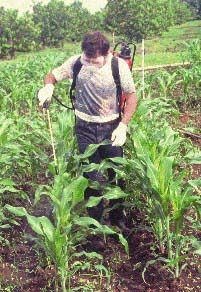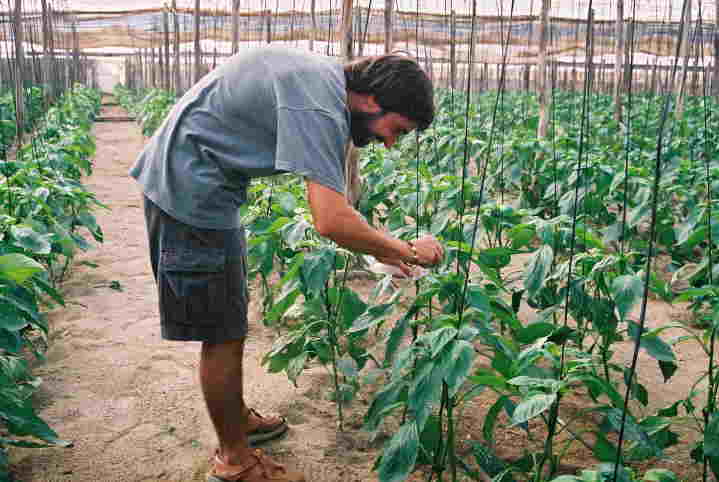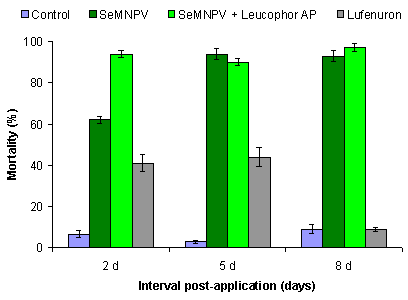| HOMEPAGE | Iridoviruses | Ecology of baculoviruses | Spinosad | Mosquitoes blackflies & ticks | Predators, parasitoids, pathogens | Others | Students | Español |  |
Baculovirus insecticides (click here for publications in PDF format) |
Baculoviruses have a number of unique features that have generated interest in their use as biological insecticides.
These include:
(i) high pathogenicity and virulence.
(ii) limited host range (very low risk to non-target insects).
(iii) absence of toxic residues on fruit and vegetables.
(iv) easily applied using conventional spray equipment.
(v) long shelf life (several years).
On the other hand, limitations include the need for often costly in vivo production, limited commercial opportunities (niche markets), low persistence when exposed to solar UV light and the need to target early instars rather than late instar pest larvae.
|

A healthy Spodoptera exigua larva feeds beside an infected cadaver. Liquid leaking from the infected corpse contains millions of viral occlusion bodies. |
| | | | | | | | | | |
|

The insecticidal properties of virus
isolates can be compared by inoculating larvae with known doses of virus
and then incubating them to determine the dose-mortality and
time-mortality relationship. |

Larvae that die from virus infection can be
diagnosed by the presence of numerous occlusion bodies (OBs) in smears
of the larval tissues (phase-contrast microscope x1000). |
| | | | | | | | | | |
In Brazil, the nucleopolyhedrovirus of Anticarsia gemmatalis (AgMNPV) is produced by several private companies.
Quality control, in terms of the number of occlusion bodies and the biological activity of each batch of virus, is overseen by a governmental body (EMBRAPA).
Unfortunately, at the moment, there is little to prevent unscrupulous businesses from selling batches of AgMNPV that have not met the quality control standards specified by EMBRAPA.
Nonetheless, virus based control of A. gemmatalis in soya
previously occured over an area of ~1.5 million hectares annually in Brazil, making this the world’s largest virus insecticide programme.
One of the most effective baculoviruses is that of Spodoptera exigua, a polyphagous pest of vegetables worldwide.
In Spain, S. exigua
is a major pest in greenhouse crops, particularly sweet peppers, watermelon, aubergine and courgette.
This pest is resistant to most of the commercially available synthetic insecticides and so outbreaks can lead to devastating losses for greenhouse growers.
Tests in southern Spain have demonstrated that the multicapsid nucleopolyhedrovirus of S. exigua is more efficient than any of the commonly used chemical insecticides.
These
findings have stimulated the registration of the virus in Spain, a patent application describing new
genotypes and novel production techniques, and the commercialization of a
product called Vir-ex by a Spanish company, Biocolor.
This
company mass-produced the virus to treat thousands of hectares of greenhouse
crops each year.
|

Testing nucleopolyhedrovirus on maize plants infested with Spodoptera frugiperda in Mexico. |
|

Sampling Spodoptera exigua larvae for virus infection on sweet pepper in greenhouses of southern Spain. |
| | | | | | | | | | |
Virus insecticides are not chemical toxins and do not work like synthetic chemical insecticides.
Therefore, formulation technology adopted from the chemical industry may not be the most appropriate for taking advantage of the unique properties of these pathogens.
The formulation of the virus can be highly influential in the efficacy of these products and we have been working on novel adjuvants that improve the pathogenicity of the virus to late instar larvae and improve the persistence of the virus on leaf surfaces.
One group of adjuvants of particular interest has been the optical brighteners, derived from stilbene compounds, such as Tinopal LPW or Blankophor BBH.
These compounds appear to degrade the peritrophic membrane in the insect midgut, thus increasing the probability of infection of midgut epithelial cells.
They can also reduce the rate of sloughing of infected cells and inhibit the suicide response of infected cells, known as apoptosis, thereby increasing the number of foci of infection in each insect that consumes viral OBs.
|

Mortality of Spodoptera exigua larvae
collected from greenhouse pepper crops at 2, 5 and 8 days post-application
and reared in the laboratory until death. The nucleopolyhedrovirus (SeMNPV) was applied alone or mixed with an optical brightener (SeMNPV + Leucophor).
A chemical treatment was included for comparison (lufenuron). Control plants were sprayed with water alone. The virus was far more efficient than the chemical insecticide
because the pest had developed resistance to the chemical (Lasa
et al. 2007).
|
| | | | | | | | | | |
|

Although virus occlusion bodies do not
persist long on the leaves of crop plants, greenhouse and field
experiments in Mexico have indicated that larvae of Anticarsia
gemmatalis rapidly acquire a lethal dose of virus (AgMNPV) (Del-Angel
et al., 2018). |
| | | | | | | | | | |
| |
Click for publications on baculovirus insecticides
| |
| | | | | | | | | | |
| Complete list of publications | Trevor Williams homepage | Sitemap |
| HOMEPAGE | Iridoviruses | Ecology of baculoviruses | Spinosad | Mosquitoes blackflies & ticks | Predators, parasitoids, pathogens | Others | Students | Español |  |






